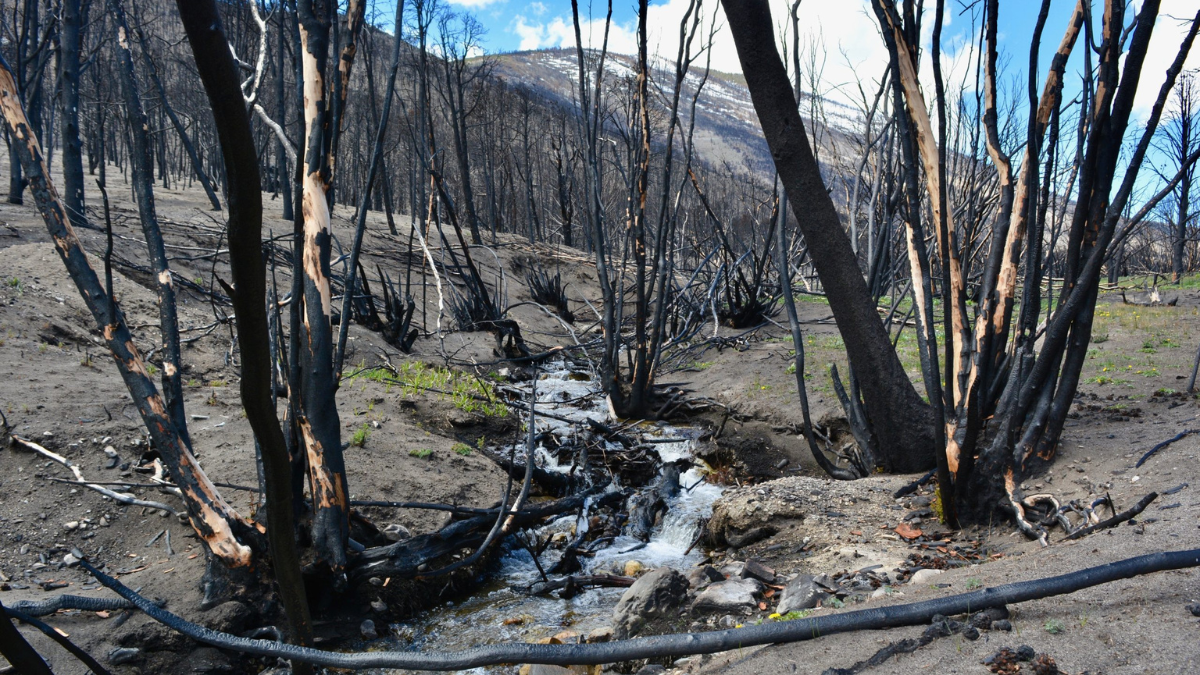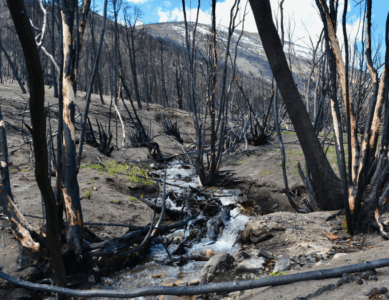Wildfires. We have all been impacted by them at some point and recently this natural disaster has been dominating headlines as more citizens are forced to deal with its repercussions. Specifically, in some provinces such as British Columbia, the wildfire season continually starts earlier and ends later, making the season last sometimes up to 2–3 months longer than historical norms and wreaking havoc on our air quality and our terrestrial ecosystems. But how does wildfires and wildfire smoke affect the water quality? Does it affect the water at all?
The answer is yes.
Recently, there is an earlier snowmelt each year, often accompanied with a reduced snowpack in the mountains from less precipitation. A thin snowpack provides less water to recharge soil and vegetation during the growing season. Combined with heat, the snow will melt earlier in the spring and create a longer dry season before the summer rains or snow return. To add an extra layer to the problem, these conditions make British Columbia’s forests become drier for a longer period, increasing flammability that can create a cascade effect on the water quality of the tributaries in the area. Specifically, in the Rockies, snowmelt runoff changes and temperature changes are being monitored due to the role they play in both streamflow decline and fuel drying which can help start or perpetuate a wildfire. Overall, changes in environmental and weather conditions have been increasing fire risk for areas surrounding waterways.
Once a wildfire occurs near a waterbody, such as lakes, it can burn the surrounding vegetation, including valuable riparian vegetation. Since riparian vegetation helps hold soil in place and filter contaminants entering the water through their root systems, the lack of their presence once burned creates increased amounts of nutrients, sediment, ash and other contaminants to be flushed into the lake and cause erosion, flooding and even possible algal blooms. Furthermore, the burned soil surrounding the waterbody can become hydrophobic, leading to even more erosion and runoff as water that would otherwise infiltrate the ground ends up entering the lake. This is particularly concerning when heavy rains follow a wildfire, as they can trigger severe flooding. In extreme cases, mudslides may occur in and around waterbodies. Such events have already been documented in recent Californian wildfires, where burned riparian vegetation, hydrophobic soils near streams, and intense rainfall have combined to produce multiple mudslides.
On an ecological level, the effects of wildfires near lakes often result in a loss of fish species, especially if water temperatures get too high, accompanied with a significant alteration in the plant regime of the waterbody. Deposits of ash and sediment in watercourses can negatively affect water clarity and water quality for aquatic organisms to the point the introduced nutrients and particles create conditions that are unable to support various aquatic organisms life. Conditions for larvae including beetle, stonefly, mosquito, and caddisfly larvae may be destroyed or significantly altered to an inhospitable point for these insects, altering the food web and ecological stability of the waterbody greatly. Lastly, the destruction of riparian vegetation causes extreme habitat loss for aquatic, terrestrial, and semi-aquatic organisms alike.
Some benefits can also arise from wildfires near lakes. Wildfires can be a source of woody debris in aquatic systems that provide both cover and a food source for insects and fish. Furthermore, wildfires have been known to recycle nutrients into ecosystems especially in forests dominated by trees such as Jack Pines. In order for the benefits to occur, the wildfires must be naturally induced which, unfortunately, is an uncommon case for most wildfires in British Columbia and consequently, normally the effects of wildfires on the aquatic ecosystems are devastating.
Therefore, as wildfires grow in frequency and intensity, their impacts on water quality serve as a powerful reminder that fire is not just a terrestrial threat, it is a watershed issue that demands integrated environmental management and urgent attention.
References
Eggert, A. (2022, July 21). Western U.S water supplies see post-wildfire bump. Montana Free Press. https://montanafreepress.org/2022/03/04/wildfire-drives-increased-water-supply/
Jain, P., Barber, Q. E., Taylor, S. W., Whitman, E., Castellanos Acuna, D., Boulanger, Y., Chavardès, R. D., Chen, J., Englefield, P., Flannigan, M., Girardin, M. P., Hanes, C. C., Little, J., Morrison, K., Skakun, R. S., Thompson, D. K., Wang, X., & Parisien, M.-A. (2024, August 20). Drivers and impacts of the record-breaking 2023 wildfire season in Canada. Nature News. https://www.nature.com/articles/s41467-024-51154-7?
Ouranos. (2025). Forest fires – impacts. Forest fires. https://www.ouranos.ca/en/climate-phenomena/forest-fires-impacts
Reid, T.-L. (2024, August 28). Impacts of wildfires on Lakes. Impacts of Wildfires on Lakes. https://blog.cwf-fcf.org/index.php/en/impacts-of-wildfires-on-lakes/
Tutland, A. N. J., Aparício, A. B. A., Sanna, A. A., Saulino, A. L., Liu, A. Y., Halofsky, A. J. E., Sathishkumar, A. V. E., Authors: Jon E. Keeley and Alexandra D. Syphard, & Wagtendonk, A. J. W. van. (2025, August 1). Fire ecology. Fire Ecology. https://fireecology.springeropen.com/


